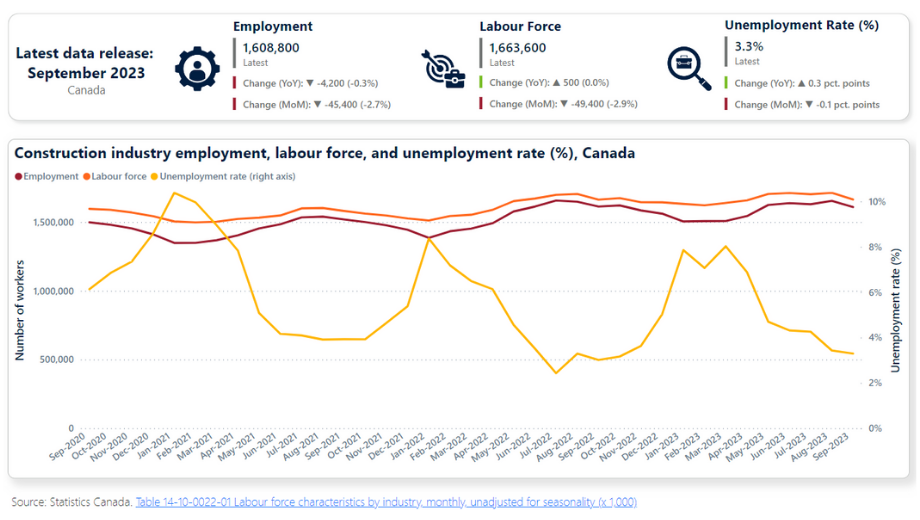The latest release of Statistics Canada’s Labour Force Survey (LFS) finds all-industry employment rose by 64,000 workers (+0.3%) in September, following an increase of 40,000 (+0.2%) in August.
The employment rate—the proportion of the population aged 15 and older who are employed—rose 0.1 percentage points to 62.0%, offsetting a decline in the previous month.
The unemployment rate was unchanged in September and stood at 5.5% for the third consecutive month.
Employment increased among core-aged (aged 25 to 54 years) women (+37,000; +0.6%) and men (+32,000; +0.5%), while it was little changed for youth aged 15 to 24 and people aged 55 and older.
Construction industry trends
Canada’s construction industry saw unemployment rate tick up marginally in September to 3.3% – up from 3.0% a year prior. This resulted as completion and wind down of several major projects decreased overall employment while the labour force held steady at 1.66 million workers.

The modest uptick in the overall construction unemployment rate should be viewed in the broader context. While at first glance, this may suggest a downturn, the current rate remains significantly below pre-pandemic levels when the unemployment rate used to hover around 4.5%.
Total construction employment in September declined by 4,000 workers – a 0.2% change compared to September 2022. Provincially, trends were mixed. Manitoba, Ontario, Quebec, New Brunswick, and Prince Edward Island, all experienced employment gains in the magnitude of 0.5% (ON) to 8.6% (MB). Quebec added 18,500 workers, a strong gain of 6.0%. Employment declines were greatest in British Columbia (-18,300 workers; -7.5%) and Nova Scotia (-7,900 workers; -17.3%), which coincides with major projects completing and winding down. Alberta and Saskatchewan also experienced employment declines of -2.4% and -1.3%, respectively.
The industry’s push to bolster its share of traditionally underrepresented workers continues to bear fruit. Female construction employment saw strong gains in September (+7,800 workers; +3.9%), bringing the female construction workforce to an all-time-high of 206,000 workers. The unemployment rate for females in September was halved, down from 4.5% in 2022 to 2.2% in 2023.
Construction employment retreats in September were more prevalent for young workers aged 15 to 24 years (-4.3%) and older workers aged 55 years and over (-4.8%). However, young workers may be finding employment in other sectors as the available labour force declined by 4.5%, driving the unemployment rate for this group of workers lower despite the employment contraction.
On a month-over-month basis, nearly all provinces saw employment decline in September from their August 2023 levels. The only two provinces that saw continued employment growth were Quebec and British Columbia. Nevertheless, most provinces saw unemployment rates fall in September as they experienced declines in their labour force.

Senior Economist & Head of Business Intelligence
BuildForce Canada.

Construction Key Indicators
